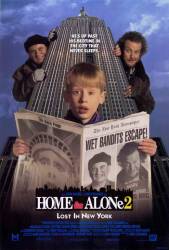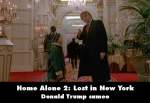Other mistake: In the scene where Kevin is making the hotel reservation on the phone, the lady does not even ask the dates of when he will be arriving and leaving the Plaza.

Home Alone 2: Lost in New York (1992)
Plot summary
Directed by: Chris Columbus
Starring: Tim Curry, Catherine O'Hara, Daniel Stern, John Heard, Joe Pesci, Macaulay Culkin
The McCallisters are going on holiday, this time they lose Kevin at the airport and he gets on the wrong plane. His family are in Florida and he is in New York. After going toy shopping, staying in an expensive hotel, and terrorizing the 'wet bandits' in his uncle's empty house, he finds his family at the end. His mother finds him at a Christmas tree and the whole family spends Christmas in New York.
Kevin McCallister: Howdy do. This is Peter McCallister, the father. I'd like a hotel room please, with an extra large bed, a TV, and one of those little refrigerators you have to open with a key. Credit card? You got it.

Trivia: In the scene where Kevin is first entering the Plaza, he stops to ask a man where he might find the lobby. The man Kevin stops is Donald Trump, owner of the Plaza.
Question: Why are they all so shocked that Kevin called Frank a cheapskate? He is. He also just practically admitted that he's not paying for this trip?
Answer: Not only was it disrespectful toward his uncle, when a kid Kevin's age says something like that, it is often attributed to overhearing and repeating what adults said. The implication is that Frank would now know what his adult relatives thought of him. They are shocked partly because they are embarrassed and feel guilty.





Answer: I think they are just more shocked with how brazen Kevin is with telling off his uncle.
Phaneron ★